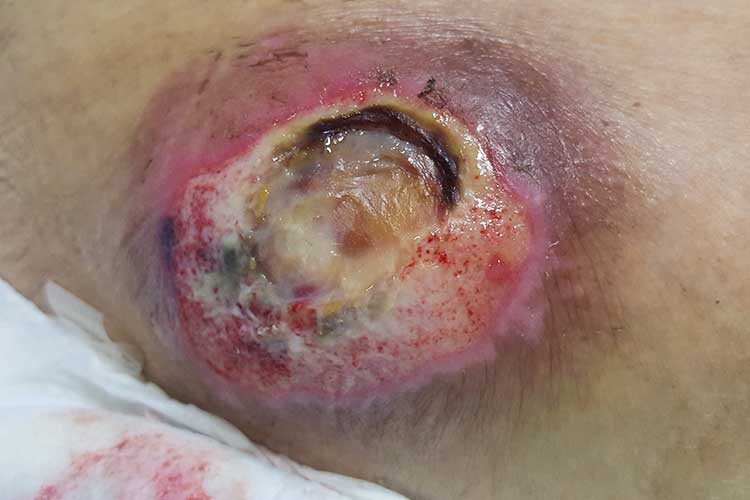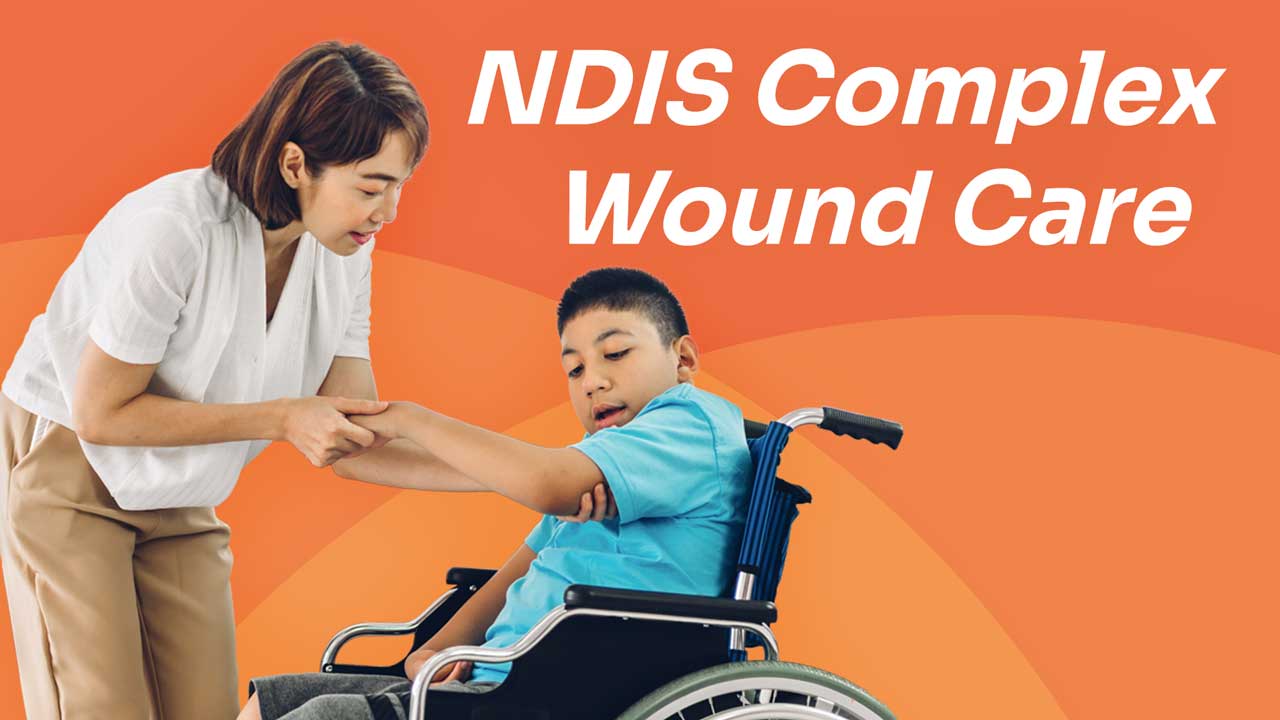Note: This article is intended for NDIS workers and providers. For a more clinically focused article on pressure injuries, see Pressure Injuries and Ulcerations.
Workers employed by National Disability Insurance Scheme (NDIS) providers, who deliver supports to NDIS participants requiring complex wound care and management, must be able to provide appropriate care.
This article will outline the wound care responsibilities of workers under the NDIS.
What are Complex Wounds?
Complex wound care support under the NDIS includes:
- Prevention and management of wounds and pressure injuries
- Supporting NDIS participants with equipment like lymphoedema machines and assistive circulatory devices.
(NDIS 2022)

Complex Wound Management in the NDIS Practice Standards
Complex wound management is a requirement of the NDIS Practice Standards under the High Intensity Daily Personal Activities Module.
This Practice Standard aims to ensure that NDIS participants who require complex wound management receive appropriate support that is relevant and proportionate to their individual needs (NDIS 2021).
Under these standards, NDIS providers must meet the following quality indicators:
- Participants are enabled to engage in the assessment and development of a complex wound management plan. This plan identifies possible risks, incidents and emergencies, and what actions need to be taken to manage these situations, including an escalation of care, if necessary. The participant’s health status is reviewed regularly (with their consent).
- Workers who provide complex wound care are informed by appropriate policies, procedures and training plans. These relate to the supports being provided to each participant.
- Workers who provide complex wound care have received all necessary training that relates to each specific participant, either from a qualified health practitioner or another appropriately qualified individual.
(NDIS 2021)
Complex Wound Care Support Skills Descriptors and Knowledge
The NDIS high intensity support skills descriptors are additional guidance specifically for NDIS workers who are supporting participants with high intensity daily personal activities (HIDPA). Many of these HIDPAs are high-risk and/or intimate care areas that require a high level of care, competency and communication. The high intensity support skills descriptors set out the skills and knowledge required for NDIS workers to effectively and safely support participants with HIDPAs (NDIS 2022).
The high intensity support skills descriptors have been updated as of 1 February 2023 in order to:
- Ensure they reflect contemporary practice and expert advice
- Align their format and language more closely to the NDIS Workforce Capability Framework.
(NDIS 2024)
Skills Required for Complex Wound Care Support
Workers providing complex wound care support under the NDIS should be able to:
- Understand and follow the participant’s support plan
- Ask the participant about their expectations, capacity and preferences for being involved in the delivery of their care
- Ask the participant about their communication preferences, and communicate in their preferred way
- Follow hygiene and infection control principles, including hand hygiene, disinfecting the environment and wearing gloves
- Ensure required equipment and components are available and prepared for use
- Ask the participant whether there are any specific considerations or adjustments needed during the provision of support
- Provide support in the least intrusive and restrictive way practicable, in alignment with the participant’s daily routine and preferences
- Position and turn the participant to prevent pressure injuries
- Assess the participant’s skin integrity for infection and take necessary steps to involve an appropriate healthcare practitioner
- Assist with the use of lymphoedema machines or circulatory assistive devices as needed
- Document information required by the participant’s support plan
- Work collaboratively with other members of the care team
- Discuss any changes needed to complex wound care support with the participant
- Identify, document and report if the participant’s support plan is not meeting their needs
- Support the participant to provide feedback or request changes to their support plan.
(NDIS 2022)
Knowledge Required for Complex Wound Care Support
Workers providing complex wound care support under the NDIS need to have the following knowledge:
- The importance of the NDIS Code of Conduct and Practice Standards
- The importance of high intensity supports in empowering participants to live the life they choose
- General and participant-specific communication aids, such as assistive technologies, alternative and augmentative communication methods, and communication devices
- Key principles of infection control and personal hygiene, such as handwashing, disinfection, and the proper use of personal protective equipment (PPE)
- The scope of their responsibilities, including supervision and delegation protocols
- The roles and responsibilities of those involved in complex wound management support, including carers, healthcare practitioners and other support workers
- Characteristics of a safe environment for delivering complex wound management support
- Common materials used in complex wound management and their purposes, e.g. dressings
- Different types of wounds and how to care for them
- How to use and troubleshoot equipment used for wound and pressure injury management
- Symptoms of pressure injuries, for example:
- Blistering
- Swelling
- Dryness
- Red, purple or blue skin
- Shininess
- Warmth
- Pain
- Risk factors for pressure injuries, for example:
- Inability to reposition self independently
- Reduced mobility
- Certain conditions, such as diabetes, spinal cord injury and multiple sclerosis
- Changes in weight
- Poor nutrition and hydration
- Incontinence
- Excess moisture on the skin
- Dry skin
- History of pressure injury
- Ways to prevent pressure areas and worsening wound status, for example:
- Routine repositioning
- Prompting participants to reposition themselves
- Dietary changes
- Using assistive equipment like lymphoedema machines or assistive circulatory devices
- The physiology of wound healing so that improvement or deterioration can be recognised
- When and how care should be escalated to an appropriate health practitioner
- Documentation requirements, such as handover, observations and incident reporting
- How to request a review of wound and complex wound management support.
(NDIS 2022; Queensland Government 2023)
Test Your Knowledge
Question 1 of 3
Which one of the following is NOT a requirement for NDIS workers providing complex wound care?
Topics
Further your knowledge
References
- NDIS Quality and Safeguards Commission 2024, High Intensity Daily Personal Activities, Australian Government, viewed 2 September 2024, https://www.ndiscommission.gov.au/providers/registered-ndis-providers/provider-obligations-and-requirements/high-intensity-daily-personal-activities
- NDIS Quality and Safeguards Commission 2021, NDIS Practice Standards: NDIS Practice Standards and Quality Indicators, Australian Government, viewed 2 September 2024, https://www.ndiscommission.gov.au/sites/default/files/2022-02/ndis-practice-standards-and-quality-indicatorsfinal1_1.pdf
- NDIS Quality and Safeguards Commission 2022, NDIS Practice Standards: High Intensity Support Skills Descriptors, Australian Government, viewed 2 September 2024, https://www.ndiscommission.gov.au/sites/default/files/2024-05/Revised%20High%20Intensity%20Support%20Skills%20Descriptors%20Dec%2022%20%28Accessible%20Version%29%20PDF.pdf
- Queensland Government 2023, Pressure Injury Prevention, Queensland Government, viewed 3 September 2024, https://clinicalexcellence.qld.gov.au/priority-areas/safety-and-quality/pressure-injury-prevention


